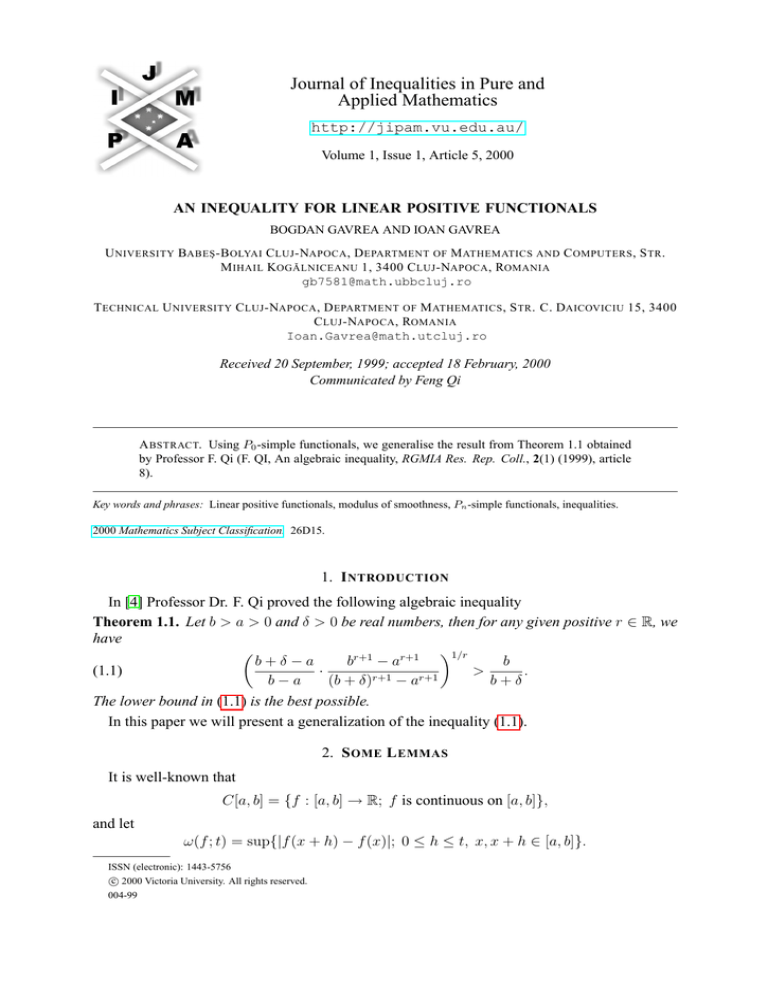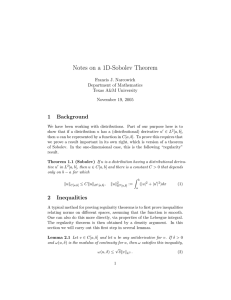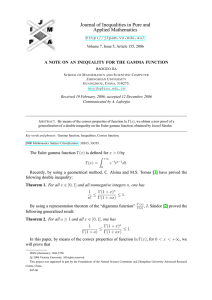
Journal of Inequalities in Pure and
Applied Mathematics
http://jipam.vu.edu.au/
Volume 1, Issue 1, Article 5, 2000
AN INEQUALITY FOR LINEAR POSITIVE FUNCTIONALS
BOGDAN GAVREA AND IOAN GAVREA
U NIVERSITY BABE Ş -B OLYAI C LUJ -NAPOCA , D EPARTMENT OF M ATHEMATICS AND C OMPUTERS , S TR .
M IHAIL KOG ĂLNICEANU 1, 3400 C LUJ -NAPOCA , ROMANIA
gb7581@math.ubbcluj.ro
T ECHNICAL U NIVERSITY C LUJ -NAPOCA , D EPARTMENT OF M ATHEMATICS , S TR . C. DAICOVICIU 15, 3400
C LUJ -NAPOCA , ROMANIA
Ioan.Gavrea@math.utcluj.ro
Received 20 September, 1999; accepted 18 February, 2000
Communicated by Feng Qi
A BSTRACT. Using P0 -simple functionals, we generalise the result from Theorem 1.1 obtained
by Professor F. Qi (F. QI, An algebraic inequality, RGMIA Res. Rep. Coll., 2(1) (1999), article
8).
Key words and phrases: Linear positive functionals, modulus of smoothness, Pn -simple functionals, inequalities.
2000 Mathematics Subject Classification. 26D15.
1. I NTRODUCTION
In [4] Professor Dr. F. Qi proved the following algebraic inequality
Theorem 1.1. Let b > a > 0 and δ > 0 be real numbers, then for any given positive r ∈ R, we
have
1/r
b+δ−a
br+1 − ar+1
b
(1.1)
·
>
.
b−a
(b + δ)r+1 − ar+1
b+δ
The lower bound in (1.1) is the best possible.
In this paper we will present a generalization of the inequality (1.1).
2. S OME L EMMAS
It is well-known that
C[a, b] = {f : [a, b] → R; f is continuous on [a, b]},
and let
ω(f ; t) = sup{|f (x + h) − f (x)|; 0 ≤ h ≤ t, x, x + h ∈ [a, b]}.
ISSN (electronic): 1443-5756
c 2000 Victoria University. All rights reserved.
004-99
2
B OGDAN G AVREA AND I OAN G AVREA
The least concave majorant of this modulus with respect to the variable t is given by
sup (t − x)ω(f ; y) + (y − t)ω(f ; t) , for 0 ≤ t ≤ b − a,
y−x
ω
e (f ; t) = 0≤x≤t≤y
ω(f ; b − a),
for t > b − a.
Let I = [a, b] be a compact interval of the real axis, S a subspace of C(I) and A a linear
functional defined on S. The following definition was given by T. Popoviciu in [3].
Definition 2.1 ([3]). A linear functional A defined on the subspace S which contains all polynomials is called Pn -simple for n ≥ −1 if
(i) A(en+1 ) 6= 0;
(ii) For every f ∈ S there exist n + 2 distinct points t1 , t2 , . . . , tn+2 in [a, b] such that
A(f ) = A(en+1 )[t1 , t2 , . . . , tn+2 ; f ],
where [t1 , t2 , . . . , tn+2 ; f ] is the divided difference of the function f on the points t1 , t2 , . . . , tn+2 ,
and en+1 denotes the monomial of degree n + 1.
Lemma 2.1 ([2]). Let A be a linear bounded functional, A : C(I) → R. If A is P0 -simple, then
for all f ∈ C(I) we have
kAk
2A(e1 )
(2.1)
|A(f )| ≤
ω
e f;
.
2
kAk
Lemma 2.2 ([2]). Let A be a linear bounded functional, A : C(I) → R. If A(e1 ) 6= 0 and the
inequality (2.1) holds for all f ∈ C(I), then A is P0 -simple.
A function f ∈ C (k) [a, b] is called Pn -nonconcave if the inequality
[t1 , t2 , . . . , tn+2 ; f ] ≥ 0
holds for any given n + 2 points t1 , t2 , . . . , tn+2 ∈ [a, b] .
The following result was proved by I. Raşa in [5]:
Lemma 2.3 ([5]). Let k be a natural number such that 0 ≤ k ≤ n and A : C (k) [a, b] → R a
linear bounded functional, A 6= 0, A(ei ) = 0 for i = 0, 1, . . . , n such that A(f ) ≥ 0 for every
f which belongs to C (k) [a, b] and is P0 -nonconcave. Then A is P0 -simple.
In [1], S. G. Gal gave the exact formula for the usual modulus of continuity of the nonconcave
continuous functions on [a, b]. He proved the following result:
Lemma 2.4 ([1]). Let f ∈ C[a, b] be nonconcave and monotone on [a, b]. For any given
t ∈ (0, b − a) we have
(i) ω(f ; t) = f (b) − f (b − t) if f is nondecreasing on [a, b];
(ii) ω(f ; t) = f (a) − f (a + t) if f is nonincreasing on [a, b].
3. M AIN RESULTS
Let a, b, d be real numbers such that a < b < d. Consider the functions ub and u∗b defined on
[a, d] by
(
1, t ∈ [a, b];
ub (t) =
0, t ∈ (b, d],
and
(
0,
u∗b (t) =
1,
J. Ineq. Pure and Appl. Math., 1(1) Art. 5, 2000
t ∈ [a, b];
t ∈ (b, d].
http://jipam.vu.edu.au/
A N I NEQUALITY
FOR
L INEAR P OSITIVE F UNCTIONALS
3
It is clear that
ub (t) + u∗b (t) = 1,
(3.1)
t ∈ [a, d].
Let A be a linear positive functional defined on the subspace S containing the functions ub
and u∗b , which satisfies
(1) 0 < A(ub ) ≤ A(e0 ), 0 < A(u∗b ) ≤ A(e0 );
(2) The functionals A1 and A2 defined by A1 (f ) = A(ub f ) and A2 (f ) = A(u∗b f ) are well
defined for every f ∈ C[a, b];
(3) A(e1 )A(ub ) − A(e0 )A(ub e1 ) 6= 0.
Theorem 3.1. Let A be a linear positive functional which satisfies conditions 1, 2 and 3 above.
Then the functional B : C[a, d] → R defined by
B(f ) =
(3.2)
A(ub f )
A(f )
−
A(e0 )
A(ub )
is P0 -simple, and
A(f )
A(ub f ) A(u∗b )
e (f ; tb ),
A(e0 ) − A(ub ) ≤ A(e0 ) ω
(3.3)
where
A(e1 u∗b ) A(e1 ub )
tb =
−
.
A(u∗b )
A(ub )
Proof. In order to prove that the functional B is P0 -simple, from Lemma 2.3, it is sufficient to
verify B(f ) ≥ 0 for every nondecreasing function f on [a, d].
It is easy to see that
(A(f ub ) + A(f u∗b ))A(ub ) − A(f ub )(A(ub ) + A(u∗b ))
A(e0 )A(ub )
∗
A(ub )A(f ub ) − A(f ub )A(u∗b )
.
=
A(e0 )A(ub )
B(f ) =
(3.4)
From the definitions of functions ub and u∗b and f being nodecreasing, we have
f u∗b ≥f (b)u∗b
(3.5)
−f ub ≥ − f (b)ub .
Substitution of inequality (3.5) into (3.4) yields B(f ) ≥ 0 for every nondecreasing function
f ∈ C[a, d].
From the equality (3.4) we get
kBk =
(3.6)
2A(u∗b )
A(e0 )
and
(3.7)
B(e1 ) =
A(ub )A(e1 u∗b ) − A(e1 ub )A(u∗b )
.
A(e0 )A(ub )
Since the functional B is P0 -simple, from Lemma 2.1, the inequality (3.3) follows.
Corollary 3.1. Let f ∈ C[a, b] be nonconcave and monotone on [a, b] and A a functional
defined as in Theorem 3.1, then
(3.8)
A(f )
A(ub f )
A(u∗b )
−
≤
(f (d) − f (d − tb ))
A(e0 )
A(ub )
A(e0 )
J. Ineq. Pure and Appl. Math., 1(1) Art. 5, 2000
http://jipam.vu.edu.au/
4
B OGDAN G AVREA AND I OAN G AVREA
if f is nondecreasing on [a, d], and
(3.9)
−
A(f )
A(ub f )
A(u∗b )
+
≤
(f (a) − f (a + tb ))
A(e0 )
A(ub )
A(e0 )
if f is nonincreasing on [a, d].
Proof. From Lemma 2.3 we have
ω(f ; t) = f (d) − f (d − t)
(3.10)
if f is nondecreasing on [a, d], and
ω(f ; t) = f (a) − f (a + t)
(3.11)
if the function f is nonincreasing on [a, d].
The functions f (d) − f (d − ·) and f (a) − f (a + ·) are concave on [0, d − a) if the function f
is a convex function. Since ω
e (f ; ·) is the least concave majorant of the function ω under above
conditions, then we get ω
e (f ; ·) = ω(f ; ·).
Combining (3.10) and (3.11) with Theorem 3.1 leads to inequalities (3.8) and (3.9).
4. A PPLICATIONS
Let a, b and d be positive numbers such that 0 < a < b < d. Consider the functional
A : C[a, d] → R defined by
Z d
(4.1)
A(f ) =
w(t)f (t)dt,
a
where w : (a, d) → R is a positive weight function.
It is easy to verify that the functional A defined by (4.1) satisfies conditions in Theorem 3.1
and the functional B can be expressed as
Rd
Rb
w(t)f (t)dt
w(t)f (t)dt
a
B(f ) = R d
− Rab
.
w(t)f
(t)dt
w(t)f
(t)dt
a
a
Then, from Theorem 3.1, we obtain
Theorem 4.1. For every f ∈ C[a, b],
R d
w(t)f (t)dt R b w(t)f (t)dt R d w(t)dt
a
(4.2)
− Rab
ω
e (f ; tb ),
R d
≤ Rbd
w(t)f (t)dt
w(t)f
(t)dt
w(t)dt
a
a
a
where
Rd
tb = Rb d
tw(t)dt
Rb
− Rab
tw(t)dt
.
w(t)dt
w(t)dt
a
Corollary 4.1. Let a, b and c be positive numbers such that 0 < a < b < d. Then we have the
following inequalities:
Z b
Z d
ab
f (t)
da
f (t)
d−b a
(4.3)
0<
dt −
dt ≤
· (f (a) − f (a + tb ))
2
2
b−a a t
d−a a t
d−a b
b
for every convex and nonincreasing function f on [a, d], where
tb =
Proof. Taking w(t) =
1
,
t2
bd ln db
ab ln ab
−
.
d−b
b−a
t ∈ [a, d] in Theorem 4.1 produces inequality (4.3).
J. Ineq. Pure and Appl. Math., 1(1) Art. 5, 2000
http://jipam.vu.edu.au/
A N I NEQUALITY
Remark 1. Letting f (t) =
1
,
tr
FOR
L INEAR P OSITIVE F UNCTIONALS
5
r > 0 in inequality (4.3) gives us
br+1 − ar+1 d − a
br
·
>
dr+1 − ar+1 b − a
dr
(4.4)
and
r
br
b
(a + tb )r − ar a
br+1 − ar+1 d − a
·
<
+
(r
+
1)(d
−
b)
· .
(4.5)
dr+1 − ar+1 b − a
dr
a + tb
dr+1 − ar+1 b
If we let d = b+δ in inequality (4.4), inequality (1.1) follows. Thus Theorem 1.1 by Professor
Dr. F. Qi in [4] is generalized.
Remark 2. We can obtain some discrete inequalities if we select the functional A of the form
A(f ) =
n+m
X
λk f (xk ),
k=1
where xk , k = 1, 2, . . . , n + m, are n + m distinct points such that
x1 < x2 < · · · < xn < xn+1 < · · · < xn+m ,
and λk , k = 1, 2, . . . , n + m, are n + m positive numbers.
Choose the point b = xn , then from Theorem 3.1, we obtain the discrete analogue of Theorem
4.1:
P
n+m λ f (x ) Pn+m λ f (x ) Pn+m λ
k
k
k=1 k
k
k=n+1 k
− k=n+1
ω
e (f ; tb ),
Pn+m
≤ Pn+m
Pn+m
k=1 λk
k=n+1 λk
k=1 λk
where
Pn+m
tb =
λk x k
Pk=n+1
n+m
k=n+1 λk
Pn
λk x k
− Pk=1
.
n+m
k=n+1 λk
R EFERENCES
[1] S.G. GAL, Calculus of the modulus of continuity for nonconcave functions and applications, Calcolo, 27(3-4) (1990), 195–202.
[2] I. GAVREA, Preservation of Lipschitz constants by linear transformations and global smoothness
preservation, submitted.
[3] T. POPOVICIU, Sur le reste dans certains formules lineaires d’approximation de l’analyse, Mathematica, Cluj, 1(24) (1959), 95–142.
[4] F. QI, An algebraic inequality, RGMIA Res. Rep. Coll., 2(1) (1999), article 8. [ONLINE] Available
online at http://rgmia.vu.edu.au/v2n1.html.
[5] I. RAŞA, Sur les fonctionnelles de la forme simple au sens de T. Popoviciu, L’Anal. Num. et la
Theorie de l’Approx., 9 (1980), 261–268.
J. Ineq. Pure and Appl. Math., 1(1) Art. 5, 2000
http://jipam.vu.edu.au/








